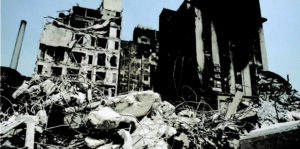At 1:15 p.m. on Tuesday, Sept.19, the annual simulacro that commemorates the earthquake on that date in 1985 had recently finished and I was working with a student in a second-floor office near the fire escape in Iztapalapa, Mexico City. He noticed something just before I did and said, “Está temblando.” The two-story descent seemed interminable. We got to where people were gathering. I saw people offer rides or glasses of water, direct traffic, and collect provisions and move them immediately toward affected neighborhoods and towns. Within hours, groups of engineers, doctors, paramedics, psychologists, lawyers, veterinarians, and other specialists were moving toward affected locales.
All of this logical and laudable activity is seen as a threat by the government, which knows that during Mexico City’s last massive earthquake, exactly 32 years earlier, citizen response to government neglect and to the earthquake itself was a key event in the building of resistance to one-party rule.
This was the second major quake in Mexico in 12 days; the first affected principally the southern states of Oaxaca and Chiapas. The officially-acknowledged death toll from Sept. 19 hovers around 350 as of this writing, with six more from a replica on Sept. 23 and many people missing.
In recent days, it has become increasingly evident that some of the most horrific accusations against state, local, and federal government officials and allied media and personnel are true, ranging from inventing a little girl (“Frida Sofía”) who supposedly was communicating from under the rubble of a collapsed private school, to government officials and military personnel actively blocking civilian efforts and confiscating relief supplies or forcing them to be surrendered to government warehouses. Volunteers and activists have asked donors and transporters of supplies to cross out barcodes on all products and write messages like “Not for resale—earthquake relief” or “No use of this material by governments or political parties is permitted.”
Government theft and repackaging of citizen-donated relief supplies
A report by Rubicela Morelos Cruz of the newspaper La Jornada and numerous personal testimonies assert that truck drivers carrying supplies from the state of Michoacán to Morelos (where Cuernavaca is the capital and Jojutla and Axochiapan are among the hardest-hit municipalities) were stopped by soldiers at roadblocks. These roadblocks prevented supplies from arriving to the state or forced them to be turned in to warehouses controlled by Elena Cepeda, wife of Governor Graco Ramírez of the Partido de la Revolución Democrática (PRD). This husband and wife team intercepts materials and puts stickers on them announcing that the relief is courtesy of the state government, i.e., them. A bizarre gender-role institutionalization persists in Mexico: When a president, governor or mayor is a married man, his wife is president of the system of Desarrollo Integral de la Familia (DIF), a vehicle for distributing patronage under the guise of social services. A similar piece in the same newspaper the next day quotes the bishop of Cuernavaca, corroborating the accusations and offering more examples. Cepeda later offered to sue the bishop for defamation (which is no longer illegal in Mexico). On Friday, about 500 people staged a Robin Hood caper and broke in to the DIF headquarters and took the supplies that were gathering dust and started to distribute them. Or was it a Pancho Villa caper? During the revolution, one thing that Villa and his troops did when they took over a town was to shut down the pawn shops and return the goods to the victims of usury.

























